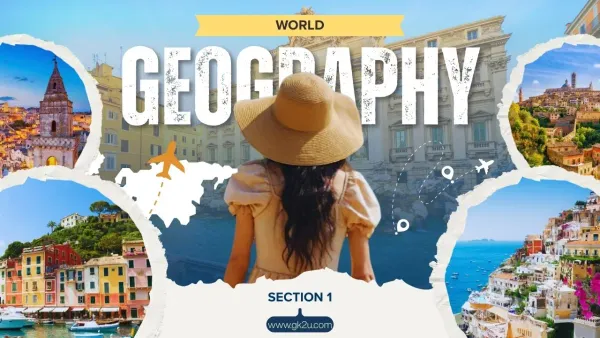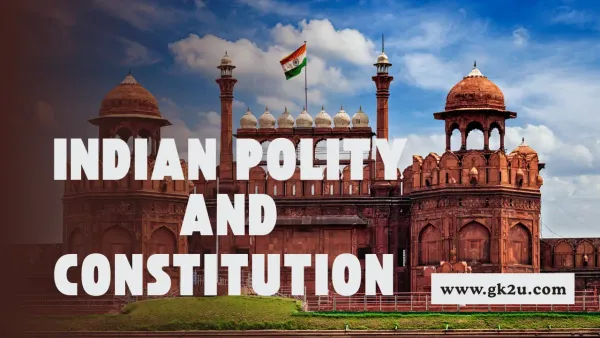Indian Geography – Part 2 MCQs & General Knowledge Notes for All Government Exams

Indian Geography General Knowledge is an essential area of study for students, competitive exam aspirants, educators, and individuals who wish to gain a deeper understanding of India’s diverse physical and socio-economic landscape. India is a country of remarkable geographical diversity, ranging from the majestic Himalayan mountain range in the north to the vast Indian Ocean coastline in the south. The study of Indian geography offers insights into the climate patterns, river systems, natural resources, soil types, vegetation zones, wildlife, states and union territories, population distribution, urbanization, agriculture, industries, and the role of geography in shaping culture and history.
Understanding Indian geography is crucial for competitive examinations such as UPSC, APSC, SSC, State PSCs, Railway Exams, Banking, Defence, and various recruitment tests. Many questions in General Studies and GK sections are directly related to physical features, climatic conditions, mineral resources, major crops, biosphere reserves, and regional development. Having strong command over these topics helps candidates score higher and develop analytical perspectives while interpreting maps and current affairs.
This comprehensive knowledge also enhances awareness about environmental issues, sustainable development, and the impact of geographical factors on India’s economic growth. Whether preparing for exams or general learning, Indian Geography GK helps individuals appreciate India’s natural beauty, cultural richness, and strategic global significance.
By studying Indian Geography systematically—through maps, charts, and factual notes—learners can build a solid foundation that supports academic excellence and informed understanding of India’s environment, society, and future challenges.
1. Which of the following is a correct sequence of seaports of India from “South to North”?
(A) Cochin →Thiruvananthapuram→Calicut→Mangalore
(B) Calicut→ Thiruvananthapuram→ Cochin→ Mangalore
(C) Thiruvananthapuram→ Cochin→ Calicut→ Mangalore
(D) Thiruvananthapuram→ Calicut→ Mangalore→ Cochin
Correct Answer: (C) Thiruvananthapuram→ Cochin→ Calicut→ Mangalore
Answer Explanation:
The correct sequence will be Thiruvananthapuram→ Cochin→ Calicut→ Mangalore
2. Which of the following states is the sole producer of agate, chalk, and perlite in India?
(A) Rajasthan
(B) Karnataka
(C) Gujarat
(D) Tamil Nadu
Correct Answer: (C) Gujarat
Answer Explanation:
Gujarat is the sole producer of agate, chalk, and perlite and is leading producer of fluorite (concentrate), fireclay, silica sand, lignite, laterite, petroleum and natural gas and bauxite in the country. The state is the sole holder of the country’s resources of perlite, 66% of fluorite, 28% of diatomite, 18% of bentonite and 12% of wollastonite. [Ministry of Mines]
3. Which among the following tributaries of Indus originates from Lake Mansarovar?
(A) Beas
(B) Jhelum
(C) Sutlej
(D) Ravi
Correct Answer: (C) Sutlej
4. Narrow water area attached with a main land in the form of channels, known as “Kayals” are found in which among the following states of India?
(A) Karnataka
(B) Maharashtra
(C) Kerala
(D) Tamil Nadu
Correct Answer: (C) Kerala
Answer Explanation:
The Malabar coast has got certain distinguishing features in the form of ‘Kayals’ (backwaters), which are used for fishing, inland navigationEvery year the famous Nehru Trophy Vallamkali (boat race) is held in Punnamada Kayal in Kerala.Kochchi Port situated at the head of Vembanad Kayal
5. Which among the following rivers originates from the Amarkantak?
(A) Betwa
(B) Mahi
(C) Narmada
(D) Tapti
Correct Answer: (C) Narmada
Answer Explanation:
The Narmada rises in the Amarkantak hills in Madhya Pradesh.The Tapi rises in the Satpura ranges, in the Betul district of Madhya Pradesh.River Betwa is the tributary of Yamuna and it rises in Vindhya ranges
6. The Farakka Barrage issue is an issue between India and Bangladesh, related to distribution of water of which among the following rivers?
(A) Ganga
(B) Brahmputra
(C) Teesta
(D) Damodar
Correct Answer: (A) Ganga
7. The Mathabhanga river is treated as an international border between which among the following countries?
(A) India Nepal
(B) India Bangladesh
(C) India Myanmmar
(D) India Srilanka
Correct Answer: (B) India Bangladesh
8. Which among the following highway connects Sikkim with the rest of India?
(A) National Highway 31A
(B) National Highway 32A
(C) National Highway 28
(D) National Highway 26A
Correct Answer: (A) National Highway 31A
9. Duncan Passage separates:-
(A) Rutland Island and Little Andaman
(B) Andaman and Nicobar
(C) North and South Andaman
(D) South andaman and little Andaman
Correct Answer: (A) Rutland Island and Little Andaman
Answer Explanation:
Duncan pass is located between the South and the little Andaman. Duncan Passage is a strait in the Indian Ocean. It is about 48 km (30 mi) wide; it separates Rutland Island (part of Great Andaman) to the north, and Little Andaman to the south.
10. Amravati Reservoir is located in which national park in India?
(A) Indira Gandhi Wildlife Sanctuary and National
(B) Mudumalai National Park
(C) Pampadum Shola National Park
(D) None of them
Correct Answer: (A) Indira Gandhi Wildlife Sanctuary and National
11. The Gulf of Kutch is one of the two regions on the west coast of India, identified suitable for Tidal power station. Which among the following is the other one?
(A) Gulf of Khambhat
(B) Laccadive Sea
(C) Gulf of Mannar
(D) None of the above
Correct Answer: (A) Gulf of Khambhat
12. Which among the following ports of India is also known as “child of partition”?
(A) Paradip
(B) Kolkata
(C) Kandla
(D) Haldia
Correct Answer: (C) Kandla
13. The Rangpo-Sivok Railway line, connects which among the following two states of India?
(A) Arunachal Pradesh ↔ Tripura
(B) Sikkim ↔ West Bengal
(C) West Bengal ↔ Tripura
(D) Arunachal Pradesh ↔ Assam
Correct Answer: (B) Sikkim ↔ West Bengal
14. Brahmaputra River when it flows out of India into Bangladesh is called as ________?
(A) Bangshi River
(B) Mahananda River
(C) Jamuna River
(D) Yamuna River
Correct Answer: (C) Jamuna River
15. Which is the only state in India producing muga silk?
(A) Assam
(B) Bihar
(C) Orissa
(D) West Bengal
Correct Answer: (A) Assam
16. Which among the following is India’s deepest landlocked and protected port?
(A) Vishakhapatnam
(B) Chennai
(C) Paradeep
(D) Kandla
Correct Answer: (A) Vishakhapatnam
17. Which among the following is not correctly matched?
(A) Ramakrishna Mission Beach – Andhra Pradesh
(B) Chandipur Beach – Orissa
(C) Golden Beach – Tamilnadu
(D) Marari Beach – Goa
Correct Answer: (D) Marari Beach – Goa
Answer Explanation:
Marari Beach is in Kerala
18. Krishna River flows through which of the following states?
(A) Maharastra, Karnataka
(B) Maharastra, Karnataka and Andhra Pradesh.
(C) Karnataka and Andhra Pradesh
(D) Maharastra, Chhattisgarh and Andhra Pradesh.
Correct Answer: (B) Maharastra, Karnataka and Andhra Pradesh.
Answer Explanation:
Krishna River rises at Mahabaleswar in district Satara, Maharashtra in the west and meets the Bay of Bengal at Hamasaladeevi in Andhra Pradesh, on the east coast. It flows through Maharastra, Andhra Pradesh and Karnataka. The delta of this river is one of the most fertile regions in India and was the home to ancient Satavahana and Ikshvaku Dynasty kings. Vijayawada is the largest city on the River Krishna.
19. Which among the following is the largest and broadest river of south India?
(A) Krishna
(B) Godavari
(C) Narmada
(D) Tapti
Correct Answer: (B) Godavari
20. Which among the following is not correctly matched?
(A) Sukhna Lake – Chandigarh
(B) Wandoor Beach – Andaman & Nicobar
(C) Bangaram Beach – Lakshadweep
(D) Devka Beach – Goa
Correct Answer: (D) Devka Beach – Goa
Answer Explanation:
Devka Beach is in Daman
21. New Moore island disappeared in the sea after many years of its creation. This island was claimed by which of the following two neighbors?
(A) India & Pakistan
(B) India & Sri Lanka
(C) India & Bangladesh
(D) India & Myanmar
Correct Answer: (C) India & Bangladesh
Answer Explanation:
It was known as New Moore Island in India and South Talpatti Island in Bangladesh. It was an unhabitated island which emerged in the Bay of Bengal in the aftermath of the Bhola cyclone in 1970. It had been created by the delta currents. It was located south of the Hariabhanga river. Now it has disappeared due to raising sea levels. With this the territorial claims of India and Bangladesh have also ended
22. To which of the following neighbor country, India ceded Kachchatheevu island in 1974?
(A) Sri Lanka
(B) Bangladesh
(C) Myanmmar
(D) Maldives
Correct Answer: (A) Sri Lanka
23. Which of the following rivers feeds the “Tehri Dam”?
(A) Alaknanda
(B) Bhagirathi
(C) Gandak
(D) Ghagghar
Correct Answer: (B) Bhagirathi
24. Bring out the only incorrect statement:
(A) Maximum Jute Mills in India are in West Bengal
(B) Maximum Jute Mills in India are in Cooperative Sector
(C) Maximum Wool produced in India is of Carpet Grade
(D) Maximum woolen units in decentralized sector in India are in Punjab
Correct Answer: (B) Maximum Jute Mills in India are in Cooperative Sector
25. Indira Gandhi super thermal power project, is located in which of the following state?
(A) Uttarakhand
(B) Haryana
(C) Punjab
(D) Uttar Pradesh
Correct Answer: (B) Haryana
26. Mullaperiyar Dam” has been a long pending issue between which of the following two states?
(A) Karnataka & Kerala
(B) Andhra Pradesh and Tamil Nadu
(C) Karnataka & Tamil Nadu
(D) Tamil Nadu and Kerala
Correct Answer: (D) Tamil Nadu and Kerala
27. Which among the following is the most optimum place to source Geothermal Energy?
(A) Konkan coast
(B) Ladakh district
(C) Aravali hills
(D) Coromandal Coast
Correct Answer: (B) Ladakh district
28. Which of the following Monsoons account for most of the rainfall in India?
(A) North East Monsoon
(B) South West Monsoon
(C) South East Monsoon
(D) East Asia Monsoon
Correct Answer: (B) South West Monsoon
29. Integrated Kashang Hydroelectric Project & Sainj Hydroelectric Project which are being supported by Asian Development Bank are located in which of the following state?
(A) Jammu & Kashmir
(B) Himachal Pradesh
(C) Uttarakhand
(D) Punjab
Correct Answer: (B) Himachal Pradesh
30. In which of the following states, India’s maximum number of mines producing minerals (excluding minor minerals, petroleum (crude), natural gas and atomic minerals) are located?
(A) Gujarat
(B) Andhra Pradesh
(C) Jharkhand
(D) Madhya Pradesh
Correct Answer: (B) Andhra Pradesh
31. Almost all of Iron Ore Production of India (96%) is confined to which among the following five states of India?
(A) Orissa, Karnataka, Chhattisgarh, Goa and Jharkhand
(B) Orissa, Karnataka, Chhattisgarh, Andhra Pradesh and Tamil Nadu
(C) Orissa, Karnataka, Chhattisgarh, Bihar & Jharkhand
(D) Orissa, Karnataka, Chhattisgarh, West Bengal and Uttar Pradesh
Correct Answer: (A) Orissa, Karnataka, Chhattisgarh, Goa and Jharkhand
32. Rama’s Bridge or Rama Setu is located in which among the following straits?
(A) Bering Strait
(B) Palk Strait
(C) Cook strait
(D) Strait of Tebrau
Correct Answer: (B) Palk Strait
33. Jarawas and Sentinelese tribes are found in which among the following state / Union Territory of India?
(A) Andaman & Nicobar Islands
(B) Madhya Pradesh
(C) Lakshadweep
(D) Arunachal Pradesh
Correct Answer: (A) Andaman & Nicobar Islands
34. Which of the following is the highest peak of Satpura Range?
(A) Gurushikhar
(B) Dhupgarh
(C) Pachmarhi
(D) Mahendragiri
Correct Answer: (B) Dhupgarh





